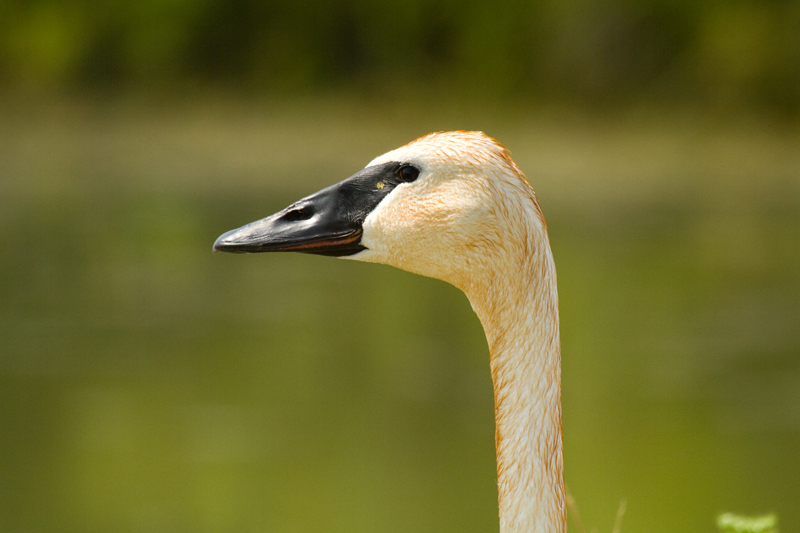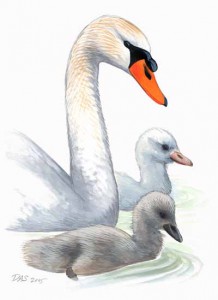
The photo above was recently sent to me by reader Wil Domke. It shows an adult Trumpeter Swan (based on bill size and shape, and on Wil’s identification in the field) with a small yellowish patch on the loral skin. This yellow marking is similar to the yellow spot shown by most Tundra Swans.
According to The Sibley Guide to Birds Trumpeter Swan is “never yellow on lores”, but obviously that is incorrect. Another example of a yellow-lored Trumpeter Swan was photographed in Ontario in early 2011 and discussed in the Outdoor Ontario forum (thanks to David Bell for pointing this out). An even earlier example from Yellowstone National Park, Wyoming, was discussed with a photo in McEneaney (2005). Finally, Steve Mlodinov (Flickr photo) reports that Trumpeters wintering in Washington “can have a dash of pallid yellow” on the lores.
Distinguishing yellow-lored Trumpeters from Tundra Swan
On seeing a swan with a yellow loral patch, many observers understandably jump to the conclusion that it is a Tundra Swan. This is the first chellenge offered by these odd individuals, but they can be distinguished from Tundra Swan by overall size, details of bill shape, and voice. In addition, the bare parts colors of yellow-lored Trumpeter Swans offer two additional clues to ID.
- yellow patch on bill dull, mottled and poorly-defined, and positioned somewhere between eye and nostril on odd Trumpeters (vs. clear yellow, sharply-defined, and positioned immediately in front of eye on Tundra)
- legs on many (all?) Trumpeters with yellow on bill are not black, instead either grayish or drab yellowish (vs always black on Tundra)
Could they be Trumpeter x Tundra Swan hybrids?
Other than the presence of yellow in the loral region there is nothing on these birds that suggests a hybrid origin. Hybrids between these two species have been reported, both in captivity and in the wild, but these hybrids are described as being intermediate in overall size and bill shape, which has not been the case in any of the well-studied birds being discussed here. One presumed hybrid identified in the wild in Dec 2009 in Skagit County, WA, was reportedly intermediate in size and had extensive yellow on the lores. In photos of that bird, the loral color appears bright yellow like Tundra Swan, and is positioned close to the eye with distinct borders there (like Tundra), but blends into drabber yellow farther from the eye (see photo by Steve Mlodinov, Trumpeter x Whistling (Tundra) Swan | Flickr).
The possibility exists that these yellow-lored Trumpeter Swans are backcrosses, or that the yellow lores are the expression of Tundra Swan genes introduced through past hybridization. Among swans, yellow lores are not unique to Tundra, so it is also possible that yellowish lores are an ancestral trait that any Trumpeter Swan can show, with no hybridization required.
Could they be leucistic swans?

Swans, of course, are all white, so the idea of identifying a leucistic swan might seem like a joke, but such birds do exist. The best-known example is the so-called “Polish” morph of Mute Swan, in which downy young are white with pink bills (unlike the typical gray plumage and dark gray bills). These white downy young molt into a nearly pure white juvenal plumage (unlike the gray-brown of typical juveniles), and can still be distinguished from typical birds even as adults by their pale grayish-yellow legs (rather than the normal black color).
A similar white or leucistic morph has long been known in Trumpeter Swan, and up to 13% of the Yellowstone population is reportedly leucistic (Mitchell and Eichholz, 2010). Kraft (1991, as reported in Mitchell and Eichholz, 2010) states that leucistic adult Trumpeter Swans can show yellowish on the lores. ((I haven’t seen the original publication reporting this connection, so I don’t know how strong the evidence is. If anyone has access to it or any further explanation I would be very interested to know about it.))
The color variants reported by McEneaney (2005) – pink, orange, or yellow legs, pink bill – could all be produced simply by a lack of melanin, and he reports that of three known leucistic Trumpeter Swans followed to adulthood in Wyoming, all three retained pale yellow-gray legs and feet, and one showed pale yellowish on the lores. ((Note that many immature Trumpeter Swans have non-black legs and feet, so this feature will only identify leucistic adults, not immatures)) Among Trumpeter Swans with pale lores, at least the Ontario bird and the Yellowstone bird discussed above showed yellowish-gray legs, not as dark as typical adult Trumpeter Swans (McEneaney, 2005), suggesting that there is a connection between leucism and pale lores.
Geographic variation?
Interestingly, leucistic downy young are reportedly not found in the Alaska breeding population (Mitchell and Eichholz, 2010), only in the Rocky Mountain population. ((I did not find clear information on the origins of the reintroduced populations in the east, but it may be that most of them came from captive stock and not from the wild. Frequency of white morph birds in the east is unknown.)) However, Mlodinov’s report that tiny pale spots on the lores can be seen in the Washington wintering population indicates either that pale lores can occur in the absence of leucism, or that there are some leucistic white morph birds in the Alaska/Washington population.
Conclusion
Trumpeter Swan can show some pale yellowish on the loral skin, and the evidence suggests that many or all of these birds are leucistic (white morph).
Questions
Are white morph birds really absent from Alaskan breeding populations?
Are all pale-lored birds also pale-legged?
Is there a direct connection between white morph and pale legs? (i.e. Do all white morph adults have pale legs, and do only white morphs have pale legs?
References
Banko, W. E. 1960. The Trumpeter Swan: Its history, habits, and population in the United States. N. Amer. Fauna 63.
Kraft, R. H. 1991. Status report of the Lacreek Trumpeter Swan flock. Pages 88-90 in Proc. and Papers of the 12th Trumpeter Swan Society Conf. (Voigt-Englund, J., Ed.) The Trumpeter Swan Society, Maple Plain, MN.
McEneaney, T. 2005. Rare color variants of the Trumpeter Swan. Birding 37:148-154.
Mitchell, Carl D. and Michael W. Eichholz. 2010. Trumpeter Swan (Cygnus buccinator), The Birds of North America Online (A. Poole, Ed.). Ithaca: Cornell Lab of Ornithology; Retrieved from the Birds of North America Online: http://bna.birds.cornell.edu/bna/species/105


Thanks for this post! In 2008, I photographed a similar individual at Ottawa NWR, OH (http://www.flickr.com/photos/andysbirds/3046269911/in/photostream/) , which had more yellow in the lores (symmetrical on both sides) but was same size and structure of the Trumpeter it was sitting with. Interestingly, the legs of this individual were black, so leucism in this bird seems unlikely. And as you pointed out with the other birds discussed, the size and structure was completely consistent with Trumpeter, so a hybrid also seems unlikely here. So maybe this individual is an example of a remnant, ancestral allele being expressed in a pure Trumpeter…
Could you elaborate on what aspects of the bill size and shape are consistent with Trumpeter Swan and inconsistent with Tundra Swan?
Hi David, yes, I’ve written before about swan identification here https://www.sibleyguides.com/2006/02/distinguishing-trumpeter-and-tundra-swans/. That’s due for updating but still explains the differences in bill shape.
Today I took a picture of a tagged trumpeter swan (Ontario C24) at Bluffers Park in Scarborough, Ontario, with very distinct symmetrical yellow motley patches between his eyes and nostrils. He had black (or very dark, anyway) legs and feet and was a large swan, otherwise the same size and shape as the other trumpeters. Let me know if you would like the picture.
Interesting, and I would like to see a picture, thanks. You can send a picture to me through the contact page (link above).
A very few Trumpeters have a yellow irregular spot on the lores and some have a clear yellow mark near the nostril.
C24 with the yellow patch on the lores was hatched at Newmarket Ontario in 2006. I know who his parents, his 4 grandparents and 2 greatgrand parents are. All are Trumpeters and none were leucistic. You will notice from the photograph that he has square feathering on the forehead, not a peak as normal Trumpeters have. The square forehead is normal with Tundra Swans. I have seen other Trumpeters with a square forehead but it is rare. The notch out of the bill of C24 was probably caused by a Snapping Turtle.
All leucistic Trumpeters have yellow and red on their bills until they are two. Their bill turns black with age but they may retain a small yellow spot until they are four. They always have yellow legs for life.
We have three leucistic Trumpeters in Ontario as of January 2012.
Harry, Thanks very much for that info! Just to clarify, I think you’re saying that leucistic Trumpeters do exist, and can be identified for their entire life by their yellowish legs, but that they can lose the yellow bill spots by age four and there are other non-leucistic “normal” swans (like C24) that can also have yellow bill spots?
I posted the following swan on Illinois Birder’s Forum of a swan I saw at Necedah NWR, this past weekend. It is roughly the same size as the Trumpeter Swan it is next to, but the amount of yellow on the bill is larger than any other pictures I’ve seen on either Trumpeter or Tundra Swans. Any thoughts appreciated.
http://www.ilbirds.com/index.php?topic=50304.0
As silly as this may sound, I wonder about the possibility of Whooper x Trumpeter hybrids in the Upper Midwest, where free-flying Whoopers have been seen in the last decade.
John and Michael, Thanks for posting this. I read the comments on the ILBirds forum and agree that it’s most likely a Trumpeter. It shows just a little more pale color there than the bird I posted about here, so it’s just a matter of degree. Presumably all swans have yellow there, masked by black, the yellow and orange color shows up because black is lacking, so technically this bird has reduced black on the bill, rather than increased yellow.
The Whooper X Trumpeter hybrid hypothesis can’t be entirely ruled out (the orange on the upper mandible could be inherited from Trumpeter, and the reduced black from Whooper) and if some free-flying Whoopers are wandering around in the region then hybrids should be watched for. For now, though, I would lean towards this being the extreme end of variation in Trumpeter. I don’t know if voice or structure differs between those two species, and how one would identify a hybrid.
I have seen and photographed c24 at bluffers park but on Sept 22nd saw and photographed an untagged trumpeter which I have mistaken for a tundra swan. I will send pictures
I photographed a pair of Trumpeter Swans with 5 cygnets today (04 Sept 2020) in Deuel County, South Dakota. These swans are thought to be an range extension of the Minnesota reintroductions (the site is close to the Minnesota border). Two of the 5 cygnets were leucistic – white plumage, pale beaks with a lack of black tip. No one is sure of the origin population of these swans – but they are the first documented breeders in eastern South Dakota. I have photographs.
Magee Marsh, Ohio, June 2011 this picture shows a Tundra swan and not a Trumpeter with yellow, they don’t exist with yellow on the lores..
i like pps
I found this pair in Kelowna, BC, in March 2021. I’m wondering what you think is going on here. They definitely seemed to be paired. There were a small flock of Tundras and Trumpeters using the same pond.
https://www.flickr.com/photos/8666250@N02/51013075486/in/photolist-2n2YwCJ-2n2VCqe-2n2QiNo-2kHNaHm-2kHSjek-2ktx9Ye-2ktx9Zw-2f12gfd-p8NVC6-2kHL8GX-2kHStr7-2kHStD6-2kHNMCY-2kHMEGW-2kHRm5f-2kHStkf-2kHMEpX-2kHPPmt-Ftn7oj-DhZfFT-Bqt9Pa-AqHdgc-B3tLuY-pNdnfS-q3suHw/
and here:
https://www.flickr.com/photos/8666250@N02/51012356733/in/photolist-2n2YwCJ-2n2VCqe-2n2QiNo-2kHNaHm-2kHSjek-2ktx9Ye-2ktx9Zw-2f12gfd-p8NVC6-2kHL8GX-2kHStr7-2kHStD6-2kHNMCY-2kHMEGW-2kHRm5f-2kHStkf-2kHMEpX-2kHPPmt-Ftn7oj-DhZfFT-Bqt9Pa-AqHdgc-B3tLuY-pNdnfS-q3suHw/
There are several other similar/related photos on the same Flickr site.